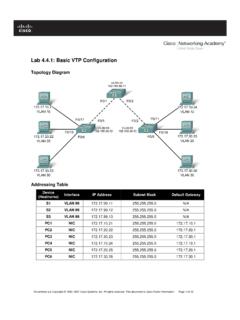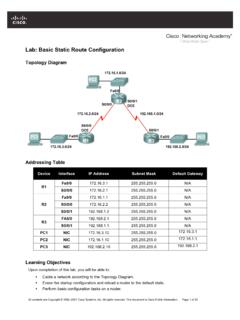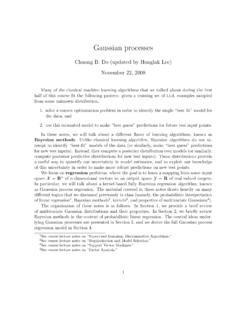Transcription of Rui Jiang Xuegong Zhang Michael Q. Zhang Editors ... - ut
1 Basics of BioinformaticsRui JiangXuegong ZhangMichael Q. Zhang EditorsLecture notes of the Graduate Summer School on Bioinformatics of ChinaBasics of BioinformaticsRui Jiang Xuegong Zhang Michael Q. ZhangEditorsBasics of BioinformaticsLecture notes of the Graduate SummerSchool on Bioinformatics of China123 EditorsRui JiangXuegong ZhangDepartment of AutomationTsinghua UniversityBeijingChina, People s RepublicMichael Q. ZhangDepartment of Molecular and Cell BiologyThe University of Texas at DallasRichardson, TX, USAT singhua National Laboratoryfor Information Science and TechnologyTsinghua UniversityBeijing, China, People s RepublicISBN 978-3-642-38950-4 ISBN 978-3-642-38951-1 (eBook)DOI Heidelberg New York Dordrecht LondonJointly published with Tsinghua University Press, BeijingISBN: 978-7-302-32359-4 Tsinghua University Press, BeijingLibrary of Congress Control Number.
2 2013950934 Tsinghua University Press, Beijing and Springer-Verlag Berlin Heidelberg 2013 This work is subject to copyright. All rights are reserved by the Publishers, whether the whole or part ofthe material is concerned, specifically the rights of translation, reprinting, reuse of illustrations, recitation,broadcasting, reproduction on microfilms or in any other physical way, and transmission or informationstorage and retrieval, electronic adaptation, computer software, or by similar or dissimilar methodologynow known or hereafter developed. Exempted from this legal reservation are brief excerpts in connectionwith reviews or scholarly analysis or material supplied specifically for the purpose of being enteredand executed on a computer system, for exclusive use by the purchaser of the work.
3 Duplication ofthis publication or parts thereof is permitted only under the provisions of the Copyright Law of thePublishers locations, in its current version, and permission for use must always be obtained fromSpringer. Permissions for use may be obtained through RightsLink at the Copyright Clearance are liable to prosecution under the respective Copyright use of general descriptive names, registered names, trademarks, service marks, etc. in this publicationdoes not imply, even in the absence of a specific statement, that such names are exempt from the relevantprotective laws and regulations and therefore free for general the advice and information in this book are believed to be true and accurate at the date ofpublication, neither the authors nor the Editors nor the publishers can accept any legal responsibilityfor any errors or omissions that may be made.
4 The publishers make no warranty, express or implied, withrespect to the material contained on acid-free paperSpringer is part of Springer Science+Business Media ( )ForewordThis ambitious volume is the result of the successful 2007 Graduate SummerSchool on Bioinformatics of China held at Tsinghua University. It is remarkablefor its range of topics as well as the depth of coverage. Bioinformatics draws onmany subjects for analysis of the data generated by the biological sciences andbiotechnology. This foreword will describe briefly each of the 12 chapters and closewith additional general comments about the field.
5 Many of the chapters overlap andinclude useful introductions to concepts such as gene or Bayesian methods. This isa valuable aspect of the volume allowing a student various angles of approach to anew , Basics for Bioinformatics, defines bioinformatics as the storage,manipulation and interpretation of biological data especially data of nucleic acidsand amino acids, and studies molecular rules and systems that govern or affectthe structure, function and evolution of various forms of life from computationalapproaches. Thus, the first subject they turn to is molecular biology, a subject thathas had an enormous development in the last decades and shows no signs of slowingdown.
6 Without a basic knowledge of biology, the bioinformatics student is greatlyhandicapped. From basic biology the authors turn to biotechnology, in particular,methods for DNA sequencing, microarrays, and proteomics. DNA sequencing isundergoing a revolution. The mass of data collected in a decade of the HumanGenome Project from 1990 to 2001 can be generated in 1 day in 2010. This ischanging the science of biology at the same time. A 1,000 genome project becamea 10,000 genome project 2 years later, and one expects another zero any time Immunoprecipitation or ChIP allows access to DNA bound by proteinsand thus to a large number of important biological processes.
7 Another topic underthe umbrella of biological sciences is genetics, the study of heredity and inheritedcharacteristics (phenotypes). Heredity is encoded in DNA and thus is closely relatedto the goals of bioinformatics. This whole area of genetics beginning with Mendel slaws deserves careful attention, and genetics is a key aspect of the so-called geneticmapping and other techniques where the chromosomal locations of disease genesare , Basic Statistics for Bioinformatics, presents important materialfor the understanding and analysis of data. Probability and statistics are basicto bioinformatics, and this chapter begins with the fundamentals including manyclassical distributions (including the binomial, Poisson, and normal).
8 Usually theobservation of complete populations such as all people in China over 35 yearsold is not practical to obtain. Instead random samples of the population of interestare obtained and then inferences about parameters of the population are guides us in making those inferences and gaining information aboutthe quality of the estimates. The chapter describes techniques such as method ofmoments, maximum likelihood, and Bayesian methods. Bayesian methods havebecome indispensable in the era of powerful computing machines. The chapter treatshypothesis testing which is less used than parameter estimation, but hypothesistesting provides understanding ofp-values which are ubiquitous in bioinformaticsand data analysis.
9 Classical testing situations reveal useful statistics such as thet-statistic. Analysis of variance and regression analysis are crucial for testing andfitting large data sets. All of these methods and many more are included in the freeopen-source package , Topics in Computational Genomics, takes us on a tour of importanttopics that arise when complete genome information is available. The subject didnot begin until nearly 2000 when complete genome sequences became a authors present us with a list of questions, some of which are listed are the genes of an organism?
10 How are they turned off and on? How do theyinteract with each other? How are introns and exons organized and expressed inRNA transcripts? What are the gene products, both structure and function? How hasa genome evolved? This last question has to be asked with other genomes and withmembers of the population comprising the species. Then the authors treat some ofthe questions in detail. They describe finding protein coding genes, identifyingpromoters, genomic arrays and a CGH/CNP analysis, modeling regulatoryelements, predicting transcription factor binding sites, and motif enrichment andanalysis.














